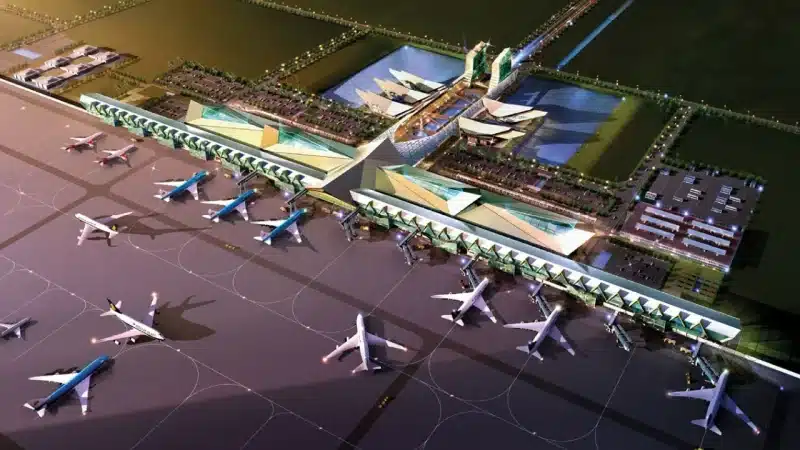Cambodia very recently opened its newest and largest airport, the Siem Reap-Angkor International Airport, after three years of construction.
This new airport is expected to boost Cambodia’s tourism industry, which is one of the largest contributors to the country’s GDP, since this airport is supposed to be the gateway for tourists to the centuries-old iconic Angkor Wat temple complex, which millions of people visit each year.
But this project came at a great price, a massive $1.1 billion funded completely by Chinese firms under the famous Belt and Road Initiative.
What are the two countries getting from this project? Will it be considered a leap towards Cambodia’s development or towards a Chinese debt trap?
The new airport
Cambodia recently inaugurated its newest and largest airport, the Siem Reap-Angkor International Airport, after three years of construction.
The new airport is located on 1,730 acres of land and has a 3,600-meter-long runway. It is expected to provide travelers with an enhanced gateway to the iconic Angkor Wat temple, a UNESCO World Heritage site and one of the most well-preserved temples in the world.
The design of the new airport was reportedly inspired by the traditional Cambodian architecture style. As for the available services, shops and restaurants that the airport offers, the official website offers minimal information. However, it does provide a full schedule of departing and arriving flights.
Even though an old airport run by the French conglomerate Vinci already existed just 5 kilometers away from the famous temple, the Cambodian Prime Minister, Hun Manet, stated the need for a new one that is farther away from the centuries-old temple.
Tourism hopes
Speaking at the inauguration ceremony, the prime minister explained that the old airport was too close to the Angkor Wat temple, and it was feared that vibrations from passing flights were damaging its foundations.
It’s no surprise that the Cambodian government was so concerned that it built the new airport 40 kilometers away from the Angkor Wat temple, since the famous temple is a key player when it comes to attracting tourists and bringing revenue to Cambodia, whose travel and tourism industry contributed to its GDP by 32.7% in 2019.
In the same year, Angkor Wat attracted around 2.2 million international tourists out of the full 6.6 million international tourists that visited Cambodia, translating into nearly $100 million in revenue for the country.
Cambodia hopes to increase the number of foreign visitors to the country with the new airport that has the capacity to handle 7 million tourists annually, up from 2 million at the old airport, and more cargo. Additionally, plans to increase that number to 12 million by 2040 were discussed.
Belt and Road concerns
Even though the project looks great for Cambodia so far, it still received its fair share of criticism when it was revealed as part of China’s massive infrastructure campaign, the Belt and Road Initiative.
Under the Belt and Road initiative, this new airport’s total cost of $1.1 billion was fully funded by China. Additionally, another Chinese-funded airport is being constructed at a cost of $1.5 billion in the Cambodian capital, scheduled for completion in 2024.
Local observers in Cambodia have warned about the possibility of the country falling into a debt trap from its involvement in the Belt and Road Initiative. They had every reason to worry since China’s massive push for the construction of large-scale, high-risk and debt-financed infrastructure has created many white elephant projects all over the world, and overburdened a lot of developing countries with Chinese debts.
In fact, a number of projects have seen some host countries, such as Sri Lanka and Laos, forced to repay their loans by handing over the operation of strategic assets to China for decades ahead.
While civil society groups in Cambodia welcome China’s Belt and Road as a new source of socio-economic development, they are also concerned about the quality, accountability, and transparency of the Chinese investments and infrastructure development projects.
What adds to their worries is the fact that 40% of Cambodia’s $10 billion foreign debt is owed to China.
However, it seems like Cambodia makes nothing of the criticism that follows the Belt and Road initiative and the threats of debt traps. In fact, Prime Minister Hun Manet said in a speech during the third Belt and Road Forum in October that the initiative has given developing countries like Cambodia advantages that include infrastructure development, increased regional and global integration, and economic growth.
Also during the forum, the Cambodian prime minister met Chinese representatives of state-owned companies, such as China Machinery Engineering, China National Energy Engineering & Construction and China Datang.
In those meetings, investments in renewable energy, a data management center, water supply upgrades, the gas sector, and new rail links were discussed. And by the end of the meetings, several memorandums of understanding about potential projects were signed.
Benefits to Cambodia and China
Back to the new airport, which is built under a ‘Build-Operate-Transfer’ deal, meaning that the Chinese companies which built the airport will be the ones operating it until 2071, that is nearly 50 years.
But again, the Cambodian government doesn’t seem to be too worried about that. In fact, it hopes that this would help bring in more Chinese tourists. This makes sense, since Cambodia is mostly visited by Chinese people, with 2.36 million Chinese tourists visiting in 2019.
After talking about what Cambodia is getting from the Belt and Road Initiative, it’s important to talk about what’s in it for China.
Aside from the 50 year ‘Build-Operate-Transfer’ deal on the new airport and other projects in Cambodia that are definitely profitable to Chinese investors, China is also fulfilling one of the Belt and Road Initiative’s most important goals, which is to increase its presence in the developing world over its western rivals.
As mentioned before, the new Chinese-funded airport was built to replace a French one. The old French airport was 70% owned by Vinci Airports and 30% by a Cambodian-Malaysian joint venture.
Vinci Airports had operated all of Cambodia’s international airports, in Phnom Penh, Siem Reap and Sihanoukville, under concessions that were agreed on in the 1990s and were supposed to run until 2040.
However, the Cambodian government had to terminate its agreement with the French company in order to move forward on the Siem Reap airport many years early. Even though its airport was replaced, the French conglomerate didn’t completely lose out, and was compensated with $63 million for the early termination.
Additionally, the old airport was given to the Chinese coalition of companies responsible for the new one, and it was told by the government to find a new use for it.
Clearly, China enjoys a very strong influence on Cambodia’s economy, shown by numerous Chinese-funded infrastructure projects like airports and roads. In addition to non-infrastructure projects like hotels and casinos all over the country.
The BRI’s future in Cambodia
Despite owing a lot of money to China, Cambodia sees these projects as a way to boost its tourism sector, which is seen as one of the main pillars supporting the country’s economy.
Like many other countries that depend on a large tourism industry, Cambodia was hit particularly hard by Covid-19. Evidently, it recorded 2.2 million international tourists in 2022, a 66% decrease compared to 2019’s 6.6 million.
As the country works to recover from the pandemic’s setbacks, its main goal is to boost its tourism again. At the beginning of the year, 3.5 million international tourists visited the country. That’s an increase of 250.8% over the same period last year, but a decrease of 19.7% over 2019.
Overall, the country’s ministry of tourism is expecting approximately from 4.5 to 5 million international tourists for the full year of 2023.
So now, the Cambodian government hopes to witness the rebirth of the tourism sector in the Siem Reap province in 2024.
However, since Cambodia was identified as a country at “risk of debt distress” by the Center for Global Development, the Cambodian government should find a way to balance the risks and returns of the Belt and Road projects, and understand that the initiative could be a double edged sword for the country.
As for the future of Belt and Road projects in Cambodia, the Cambodian prime minister has made it clear that the country remains as interested as ever in more Chinese investments. If the new airport takes off and becomes a success, then China and its initiative will surely have many more miles to run.
Right now, the most important thing for the Cambodian government as it seeks to develop its relationship with China is ensuring that the major Belt and Road investments deliver their promised winning outcomes for Cambodia over the long-term.
This should be a main goal for China as well, since it could prove how much Beijing is in tune with developing countries and their needs, and that there’s more to the Belt and Road Initiative than debt traps.
Disclaimer
Please visit and read our disclaimer here.









